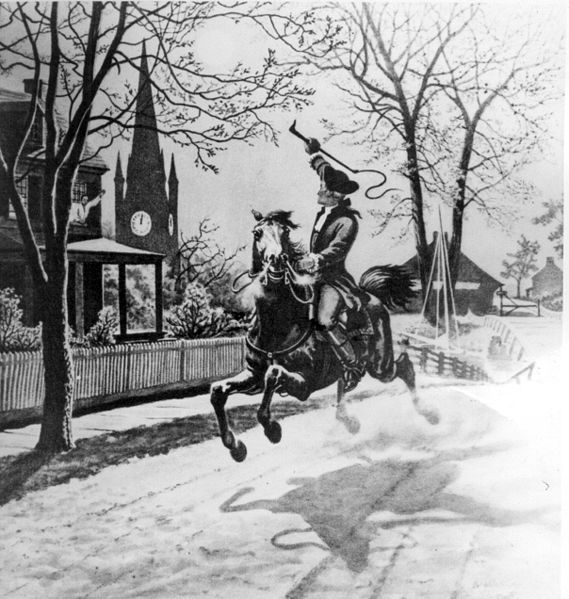http://en.wikipedia.org/wiki/File:Paul_Revere’s_ride.jpg
In October, 1804 a major hurricane struck New England and dumped 2-3 feet of snow on the region. The storm blew over the steeple of the Old North Church in Boston – one of the first hangouts of those reviled “teapartiers.”
While we can’t specifically tie this particular event to emissions from Paul Revere’s horse, we do expect these types of extreme weather events to become more common as man made greenhouse gases accumulate in the atmosphere.
http://www.massmoments.org/moment.cfm?mid=293
The storm that left such a profound mark on Massachusetts began on the evening of Tuesday, October 9, 1804, when the temperature plummeted and rain and snow began to fall, accompanied by thunder and lightning. During the night and next morning, the wind blew from the southeast, but by the afternoon of the 10th, the wind had shifted to the northeast and increased in intensity. As Sidney Perley recorded in his 1891 book on historic storms of New England, “the wind reached its height in the evening,. . . People sat up all that night, fearing to retire lest their houses would blow down. Wednesday morning [the 10th] revealed the streets in town encumbered with sections of fence, whole or parts of trees, and many other things that the wind could carry away; the town and county roads everywhere were obstructed with fallen trees.”
Just as the wind began to die down, it began to snow and snowed throughout Wednesday and into Thursday, with accumulations from five to 14 inches. In southern New England it melted in a few days, but further north it stayed on the ground until the following spring. It had been 50 years since the people of eastern Massachusetts had experienced such an early storm, and even the oldest inhabitants could not remember such a violent one.
Orchards were ruined when boughs, laden with ripe fruit, snapped under the weight of the snow. The woods resounded with the hideous noise of breaking tree limbs, dealing a severe blow to the region’s shipbuilders. Large numbers of cattle, sheep, and fowl were killed, especially in the Essex County towns of Newbury and Topsfield.
“Such great sections of woods were leveled that new landscapes and prospects were brought into view to the surprise of many people. Houses and other buildings and hills that could not be seen before from certain places were now plainly visible. The change was so great in some localities that the surroundings seemed to have become entirely different, and people felt as if they were in a strange place.”
“Buildings and chimneys were blown down or greatly damaged by the wind.” Many churches lost spires and steeples, including the famous North Church in Boston. Few barns, sheds, or chimneys escaped unscathed. Roofs were blown off, houses collapsed, and many people lost their lives. Streets were filled with the debris of destroyed buildings, fences, and trees.
The most damage, however, occurred to wharves and ships. “Many vessels in the harbors dragged their anchors or broke their cables, and dashed against each other or the wharves, or were driven upon lee-shores and wrecked.” Many seamen died as ships were run ashore or against reefs and sand bars. The sloop Hannah was blown out of Cape Ann harbor and struck a ledge off the shore of Cohasset, many miles to the south. The first wave that swept the deck carried off the crew with the exception of “two men who lashed themselves to the boom and remained on deck about two hours until the vessel went to pieces, when the boom with the men still lashed to it washed ashore. Several of the citizens of Cohasset saw the men plunging in the surf, and came to their assistance saving them when they were nearly exhausted.” The Hannah was one of five vessels wrecked on the shores of Cohasset during the storm.



I doubt Paul Revere’s horse’s flatulence wafted around new England for 28 years. it was probably just the factories they were smelling. 😉